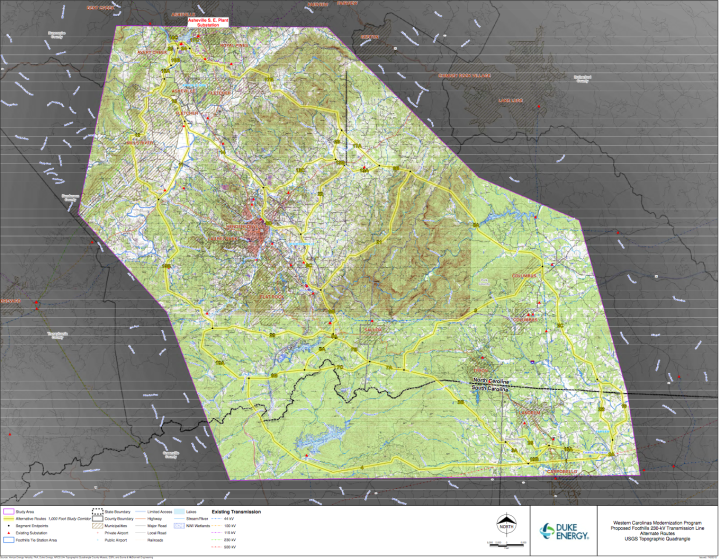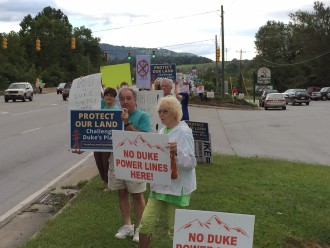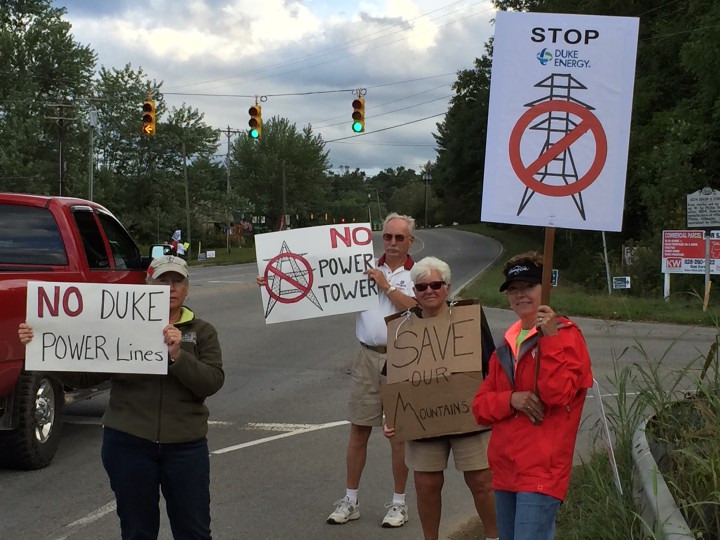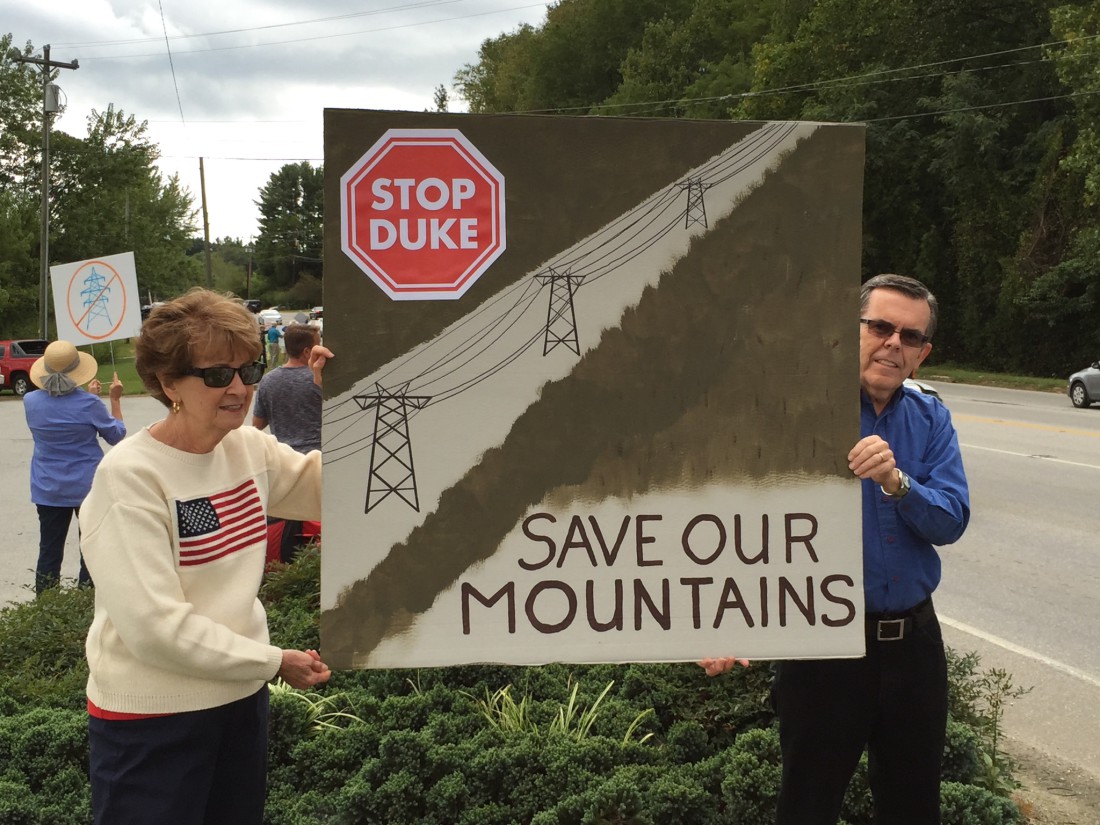Editorial update [9/21]: Xpress originally reported that Duke Energy would be unable to follow existing right of ways in WNC for the Foothills transmission line project due to Federal security concerns. Duke Energy has since clarified that this information was in regards to the existing Pisgah right of way solely and that other existing right of ways are being considered as potential routes within the scope of Duke’s study whenever feasible. The content of the article has been updated to reflect this information.
Power giant Duke Energy’s proposal for a 45-mile transmission line through Western North Carolina, part of the company’s multifaceted Western Carolinas Modernization project to upgrade and integrate the mountains with a larger regional power grid, is meeting staunch opposition from residents since the company announced its intentions in mid-July.
Homeowners, local municipalities and environmental groups in and around Henderson County have raised concerns over the economic and ecological impact of the project and are calling on Duke to consider less-invasive alternatives, such as using existing routes or burying the line underground.
Although Duke and the North Carolina Utilities Commission have been urging patience while an official proposal for the project is being finalized, community members have been speaking out about their reservations and literally taking to the streets in a vigorous display of social activism to protect their homes and livelihoods from the perceived threats.
Plotting the course
The wide-ranging Western Carolinas Modernization project aims to improve WNC’s connections to Duke’s power grid; replace the existing 376-megawatt Asheville Plant in Fletcher with a more efficient gas-powered plant; clean up existing coal ash basins around the Asheville area; and implement state-of-the-art energy-producing technologies, according to Thomas Williams, a spokesperson for Duke Energy.

Western North Carolina has historically been difficult to supply with power, he notes, due to its relative isolation from the rest of the company’s grid. “There’s not many wires to bring the power into the area, and there’s not much power generated in the area itself to meet the demand.”
According to Williams, demands for energy in the foothills of South Carolina and Western North Carolina have more than doubled since the 1970s, the last time the grid was significantly upgraded in this region. Duke saw record energy-consumption levels as temperatures plummeted during the polar vortex in the winter of 2014, when power usage briefly spiked to 1,183 megawatts, and again in the early months of 2015.
“We got very worried when we saw that [30 percent usage] increase in one year,” says Williams, who keeps a home in Fairview and saw the effects of the bitter winter. “We were pretty much right on the wire in terms of having planned rotating blackouts for a very brief period.”
In response to this scare, and partially as a result of the coal ash controversy raised by the Dan River spill in 2014, Duke decided to phase out the existing Asheville coal plant and diesel generator, which Williams describe as “dirty and inefficient.”
The new gas plant will be capable of generating at least 650 megawatts of energy at any given time — twice the capacity of the current coal plant — and will be 35 percent cheaper to operate, according to Williams. The move will also save Duke roughly $100 million dollars in ash-cleanup costs and upgrades that would have been necessary for the existing plant. Current estimates envision the gas plant to be fully operational by 2019.
Duke’s Western District encompasses Avery, Buncombe, Haywood, Madison, Yancey and Mitchell counties, as well as parts of Henderson, Jackson and McDowell counties and several areas in upstate South Carolina. In order to serve this vast region, Williams says Duke must install a 500,000-volt line to connect the Asheville plant to a new substation in Campobello, S.C. The proposal, officially titled the Foothills Transmission Line & Substation project by Duke, is necessary for moving large quantities of energy efficiently across long distances.
“Right now, Duke Energy/Progress West has no [direct] access to [the overall] system,” says Williams. “What this wire will do is give us a direct feed from that system into DEP West for the first time,” allowing Duke to transfer power to its customers throughout WNC and upstate South Carolina as needed, while also decreasing the reliance on less-efficient coal plants in other areas within Duke’s service provider network.
In anticipation of this project, Duke has identified several possible corridors through Buncombe, Henderson and Polk counties through which to run the new transmission line. “We need to be able to move power in,” says Williams, “and when you build a 650-megawatt plant that’s very efficient, that’s going to run much more often and is cleaner than a coal plant, we need to be able to ship that power out too.”
However, finding a route that serves this purpose without significantly impacting existing communities along the way has become a dicey prospect. The transmission lines would rise to approximately 140 feet, depending on the terrain, with approximately 1,000 feet between each tower. The type of lines needed for this project would require a right-of-way of anywhere from 125 to 150 feet wide, raising concerns that scenic views may be obstructed and that residents’ properties as well as ecologically sensitive areas along the route may be negatively impacted.

“This transmission line is going through the prime growth area for our community,” says Greg VanVorhis, who helped form a coalition this summer of approximately 1,000 homeowners and businesses around Henderson County to oppose Duke’s suggested routes in the Mills River area. (An interactive map of the potential transmission line corridors and existing features is available on Duke Energy’s website here.)
“Segments 12 and 10B run in very close proximity to [several] subdivisions,” says VanVorhis, a resident of the Mill Ridge subdivision. “Route 12 would cross North Mills River at three different points, as well as North Mills River Road, which is the main access point to the recreation facility in Pisgah National Forest.” He adds that property around the Kanuga Conference Center in Hendersonville, the Lodge Rehabilitation Center and several other subdivisions would also see some degree of impact.
Williams says that while Duke understands residents’ concerns, the company is limited in the available options for where it can place the transmission line. “People have suggested we follow the highway, but we can’t do that because [the North Carolina Department of Transportation] won’t let us: there’s not enough right-of-way.”
Other suggestions, such as running the new line parallel to existing Pisgah line, have been nixed by the federal government due to the security risks that arise from having such vital lines in close proximity to each other. And the option of cutting a new right of way through Pisgah National Forest, as has been done in the past, can only be considered if no other alternatives are available, which Williams says is not the case in this instance.
“We have other regulations we have to follow,” says Williams. “We’re trying to do this in the least impactful way we possibly can.”
This includes studying other existing right of ways to run the new lines parallel to, says Williams. “That is often our preference whenever possible in the overall site selection process,” he notes, adding that Duke Energy is “looking at those options very seriously and weigh them high in the criteria [in evaluating potential routes].”
But recent history has soured Duke’s reputation among many residents and created an air of suspicion regarding the energy provider’s transparency and intentions.
“Duke has not had a good track record, as far as being trustworthy, with the coal ash pollution and other issues,” says VanVorhis. “There’s lots of different alternatives, and they have not sufficiently justified why this has to happen.”
Power to the people
This summer, hundreds of community members from across the region attended three open house meetings over the course of July in the Fletcher and Flat Rock communities and in Landrum, S.C. after Duke sent out more than 3,700 letters to residents whose property falls within 500 feet of one of the proposed transmission routes.
Among those attendees was Phillip Brown, a farmer and resident of Mills River, whose family has lived in the area since the 1830s. “I attended the meeting at the Ag center, and the turnout was tremendous,” says Brown, who runs a small organic family farm in one of the areas currently under consideration for the transmission line project.

Brown says that he was disappointed with the public forum’s results. “The only thing I found out was that my home was on the line, and a Duke representative told me that if that route was chosen and we refused to sell to Duke, the state would condemn the place.”
If Duke decides to build in the corridor near his property, Brown fears that his farm’s impending organic certification could be in jeopardy due to the use of herbicides in the right-of-way. He also worries that an heirloom apple orchard, originally planted by his great-grandfather and currently owned by his friend and neighbor Ken Cole, could be lost. “If Duke runs either of two of its option routes here, several hundred of my great-grandfather’s heirloom apple trees would have to be destroyed,” says Brown.
He’s not alone in his concerns, he says. “There are similar stories all over Henderson County. In our immediate neighborhood, there are at least four homes inside the corridor that could potentially be condemned. The impact on communities, farms and families that have literally been here for generations have largely been answered only vaguely.”
In an effort to bring these concerns to the forefront, more than 85 community members gathered at the Mills River Valley Ag Farm & Garden store on the afternoon of Saturday, Sept. 12, to publicly protest the transmission line proposal.
“The groundswell of discontent is like nothing I’ve ever seen,” says Brown, who notes that “folks around here don’t tend to protest.” In this circumstance, however, he believes that people are angry about the possibility of losing land and their livelihoods. “To many of us, it’s the only thing we’ve got.”
Local matters
Municipalities and environmental groups around the study area have also joined the chorus of those opposing Duke’s plans. On Aug. 14, the Mills River Town Council issued a resolution in opposition to any transmission line being located inside town limits.
The council proclaimed that it “recognizes and supports Duke Energy in its endeavor to provide electric power service to its residents and other Western North Carolina property owners,” but “also recognizes the potential for loss of land, potential loss of homes, loss of businesses and/or loss of agricultural land to property owners.” The council concluded by “vehemently oppos[ing] any route for a new or improved transmission line that would affect the property owners.”
Following suit, the Hendersonville City Council called a special meeting Sept. 10 to address the impact of the project on the city. Citing “negative impacts on Hendersonville property owners and the Hendersonville economy,” the council issued an official resolution calling for the “proposed transmission line [to] be located within either existing power transmission line easements or immediately adjacent and parallel” to them, even if the cost is greater to do so.

The uproar over Duke’s proposals has also caught the attention of local conservation advocacy organization MountainTrue,which is helping to support residents opposing the Duke project.
“We’re concerned that Duke is placing a huge burden on our area’s communities and all Duke Energy ratepayers without sufficient justification that this is the best and least impactful plan,” says Joan Walker, campaign coordinator for MountainTrue.
To assist in organizing the opposition, MountainTrue helped create the Carolina Land Coalition, which serves as “a platform for community members to speak out and coordinate their efforts,” according to Walker. The CLC currently counts 16 community organizations and more than 1,020 people among its members.
“We are sharing information, supporting people in having their voices heard and getting the word out about Duke’s plans to people who may not have heard what’s going on,” Walker says. She refutes Duke’s claims that the new gas plant is a positive step toward reducing carbon emissions, asserting that, “Duke will be locking us into at least another 30 years of reliance on dirty, expensive fossil fuels,” rather than utilizing renewable and efficient energy alternatives.
Walker encourages citizens interested in finding out more about Duke’s Foothills project and how they can speak out to visit carolinalandcoalition.org for updates.
Waiting on an answer
Duke Energy will spend the rest of September studying the selected routes and processing comments submitted by the public before submitting its official proposal to the North Carolina Utilities Commission.
“I think by the first of next month, we’ll let people know firstly what’s going to be the preferred route,” says Williams, the Duke spokesperson. “Then we have to go through a whole hearing process after that.”
According to its website, the NCUC will review Duke’s application and hold public hearings on the proposal in Asheville and Raleigh. The Hendersonville City Council resolution has also called for the commission to hold hearings in Henderson County as well.

The NCUC will then review Duke’s plan and the comments from the public hearings and issue an official order on whether the power company can begin work on the transmission line. The decision will be based on “whether the public convenience and necessity requires construction of the proposed electric transmission line.” The commission will also decide if Duke’s proposed route for the transmission line is the most logical and appropriate corridor available. A determination on this is expected sometime in early January 2016, according to the NCUC webpage.
In the meantime, Williams says Duke is taking every feasible precaution to accommodate the community’s concerns. “We want to talk to the people and make sure Aunt Betty’s not buried in the backyard in a cemetery we don’t know about, or that there’s not an Indian mound there or a frog that’s only native to [that area]. That’s why we do these assessments.”
The public will be able to view updates on proposals and public filings by Duke on the NCUC website ncuc.net during this period.
“We hope Duke will make good on their repeated promise to be a good steward and community partner and find a different, less-invasive way to provide reliable power,” says Walker. Holding the energy company accountable, she notes, hinges on “folks coming together to challenge this plan for the long haul — with the public utilities commission and the courts if need be.”
And while some may see the current public outcry as a flash in the pan that will quiet down once plans are finalized, Brown contends that such social activism has deep roots in his community. “When things get hard we close ranks and come together — it’s what we’ve always done, and it’s what we’ll do now, for as long as it takes,” he says. “Duke may have money, but we have family, and to country people like us, family is everything.”




Tom Williams says Duke is being sensitive to the area and the public’s concerns. There are a couple points that need clarification in his statements. First is the capacity of electricity import capability into the Lake Julian/Skyland plant. The 230 KV line that comes over the Escarpment from around Cleveland, SC is dual-circuit. This means there are actually 2 230KV circuits on the towers. Notice there are 6 large wires and 2 smaller guy wires or lightning arrestors the next time you drive by the line. Each of the 230 KV circuits is capable of carrying 400 megawatts. Duke has claimed they rate the line at 600 megawatts but also claims they are only capable of 400. I’ve heard them say the 600 MW number in the public meetings, so this is what we’ll go with.
The current coal fired plant generates 376 MW of electricity. Duke also has what are called “peaking generators” that are used on very rare occasions and over history, they’ve only actually been used 2.4% of the time because the main generators and the import capability more than make up for need. In fact, most of the time the main generator is only running at idle because the import capability is sufficient and economical for them. The “Peakers” can generate up to 378 MW of power.
So, if we add the 376 MW of main generation capability, the 378 MW of peaker capacity and the 600 MW of import capability, we come up with a number of 1,354 MW of capacity, nowhere near the 1183 MW Mr. Williams claims were needed for that brief time. By the way, that brief time he mentions was a few hours of the ENTIRE winter.
There are alternatives.
First, Duke Energy has been offered approximately 380 MW of safe, renewable and available hydro power from Brookfield Renewable Partners. The power is generated from the hydro turbines at Lake Santeetlah and two other lakes. There is already a right of way running to a substation in Sylva and I’ve not found a good Duke/Progress route map to show just how close additional existing routes are. There is a large substation in Enka, so connecting would is possible. This is electricity not being used by TVA or anyone else and is available now.
Second, if Duke were to reconfigure the design of what they are proposing for Lake Julian they would have the ability to run an efficient plant, they would have redundancy and modular growth capability. The 2 x 1 combined cycle design they are proposing in their 2015 Integrated Resource Plan (IRP) does not lend itself to a “regional” solution. What they are actually doing is trying to repurpose the site from a regional generation plant to a 7 x 24 x 365 baseline plant designed to energize the Duke grid. They will tell us the power generated from the plant is going to be sold to Duke customers in the Carolinas but once the main 525 KV trunk is energized with power from any power plant, those electrons could end up anywhere along Duke’s main trunks along the east coast of the US.
If Duke were to design a smaller plant that could be scaled back when power is not needed or cycled up when demand warrants, they would have a solution fitting need. By choosing the right design, they could also add gas turbines as needed in a scalable solution and the need for sending power anywhere other than WNC would be eliminated. The 2 x 1 combined cycle design must be run at least 50% or so of capacity, removing the capability of being versatile and adaptive to the situation.
The combined cycle/transmission line/substation solution Duke is proposing is also very expensive and that’s exactly why Duke wants to go this route. Their return on equity (ROE) from this project, if approved, will amount to about $870 Million in the first year of operation and over a 30 year depreciation cycle and calculated lifetime will provide Duke and their shareholders with about $1.25 BILLION in profits.
Guess who will be paying for this in higher electricity rates.
This project is not about supplying power to WNC. It’s about providing “shareholder value” at the expense of everyone along the substation or transmission line routes and the ratepayers that will have to pay for it. Don’t be fooled.
CORRECTION. That’s $87 Million in the first year. Sorry for the decimal error.
Mr. Schager, I am happy to discuss your concerns about my comments or our plans to met the peak needs of the Western Carolinas area – which we are required to do 24 by 7 with an operating reserve of about 15 percent. Federal regulations also require us to plan and have transmission import capability for the possibility of losing our largest unit in the control area, which is a relatively small control area we call Duke Energy Progress West.
We also will be detailing the plan and need in regulatory filings and subsequent hearings before the utility commission.